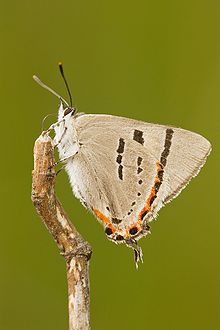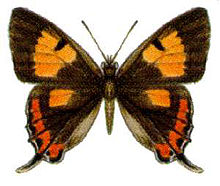- Silky Hairstreak
-
Silky Hairstreak 
Scientific classification Kingdom: Animalia Phylum: Arthropoda Class: Insecta Order: Lepidoptera Family: Lycaenidae Genus: Pseudalmenus Species: P. chlorinda Binomial name Pseudalmenus chlorinda
Blanchard, 1848[1]The Silky Hairstreak (Pseudalmenus chlorinda) also known as the Chlorinda Hairstreak is a butterfly belonging to the family Lycaenidae. It occurs in Australia.
Contents
Taxonomy
The Silky Hairstreak was first described by Emile Blanchard in 1848. Subspecies include[2]:
- P. c. chlorinda is found in Tasmania. [2]
- P. c. myrsilus is found in a restricted area of south-east Tasmania. It is classified as rare under the Tasmanian Threatened Species Protection Act 1995. [3]
- P. c. zephyrus is found in Eastern Victoria[2]
- P. c. fisheri is found in the Grampians National Park, Victoria[2]
- P. c. chloris is found around Katoomba and Mittagong, New South Wales[2]
- P. c. barringtonensis is found in the area of Barrington Tops, New South Wales[2]
Description
The adult Silky Hairstreak has a wingspan of 28mm.[4] The male and female are similar, with the wings of the female slightly more rounded.[1] The wings are black or brown on top with yellow-orange patches. The lower wings have orange patches and black tails with white edges. The underside of the wings is yellow-grey in colour with black and orange markings. The eggs are pale green with a diameter about 1mm.[1] They are usually laid in small groups on the twigs of a food plant.[1]
The caterpillars grow to a length of around 3 cm. They have a black head and a brown, red, black and yellow body.[1] The larvae of the Silky Hairstreak secrete substances that attract Anonychomyrma biconvexa ants.[5][6]
Distribution and habitat
It is found in South Eastern Australia including New South Wales, Victoria and Tasmania.[7] The species only occurs where the attendant ant species is found, and the larval food plant grows.[8]
The caterpillars feed on various Acacia species including the Silver Wattle, Acacia decurrens, Acacia elata, Acacia mearnsii, Acacia melanoxylon, Acacia obtusata, Acacia pravissima, Acacia terminalis and the Acacia trachyphloia.[1]
See also
- Papilionidae
- List of butterflies of Tasmania
References
- ^ a b c d e f "Pseudalmenus chlorinda". Australian-Insects. http://australian-insects.com/lepidoptera/lyca/chlorin.html. Retrieved 20 December 2009.
- ^ a b c d e f "Pseudalmenus chlorinda". www.funet.fi. http://www.funet.fi/pub/sci/bio/life/insecta/lepidoptera/ditrysia/papilionoidea/lycaenidae/theclinae/pseudalmenus/index.html. Retrieved 20 December 2009.
- ^ "Threatened Fauna Manual for Production Forests in Tasmania - Tasmanian Hairstreak Butterfly". http://www.fpa.tas.gov.au/__data/assets/pdf_file/0006/68109/Haristreak_2011.pdf. Retrieved 5 November 2011.
- ^ "Victorian (Silky) Hairstreak Butterfly". Museum Victoria. http://museumvictoria.com.au/forest/animals/hairstreak.html. Retrieved 20 December 2009.
- ^ "Species Pseudalmenus chlorinda". Australian Biological Resources Study. http://www.environment.gov.au/biodiversity/abrs/online-resources/fauna/afd/taxa/Pseudalmenus_chlorinda. Retrieved 20 December 2009.
- ^ "Lycaenid butterflies and ants". Australian Museum. http://australianmuseum.net.au/Lycaenid-butterflies-and-ants/. Retrieved 20 December 2009.
- ^ Kitching, Roger (1999). Roger Laurence Kitching. ed. Biology of Australian butterflies. CSIRO Publishing. ISBN 0643050272, 9780643050273.
- ^ Zoological Catalogue of Australia Volume 31.6: Lepidoptera: Hesperioidea, Papilionoidea. CSIRO Publishing. 0643067000, 9780643067004. http://books.google.com.au/books?id=iVHDuVVelGMC&pg=PA270&lpg=PA270&dq=Anonychomyrma+biconvexa+Silky+Hairstreak&source=bl&ots=s9cGmAs4hk&sig=YOe_RVbS0JMoAmiIPrRtV3K80xE&hl=en&ei=QRwuS_zSO4rs7APD24CDBg&sa=X&oi=book_result&ct=result&resnum=2&ved=0CAsQ6AEwAQ#v=onepage&q=Anonychomyrma%20biconvexa%20Silky%20Hairstreak&f=false.
External links
Categories:
Wikimedia Foundation. 2010.

